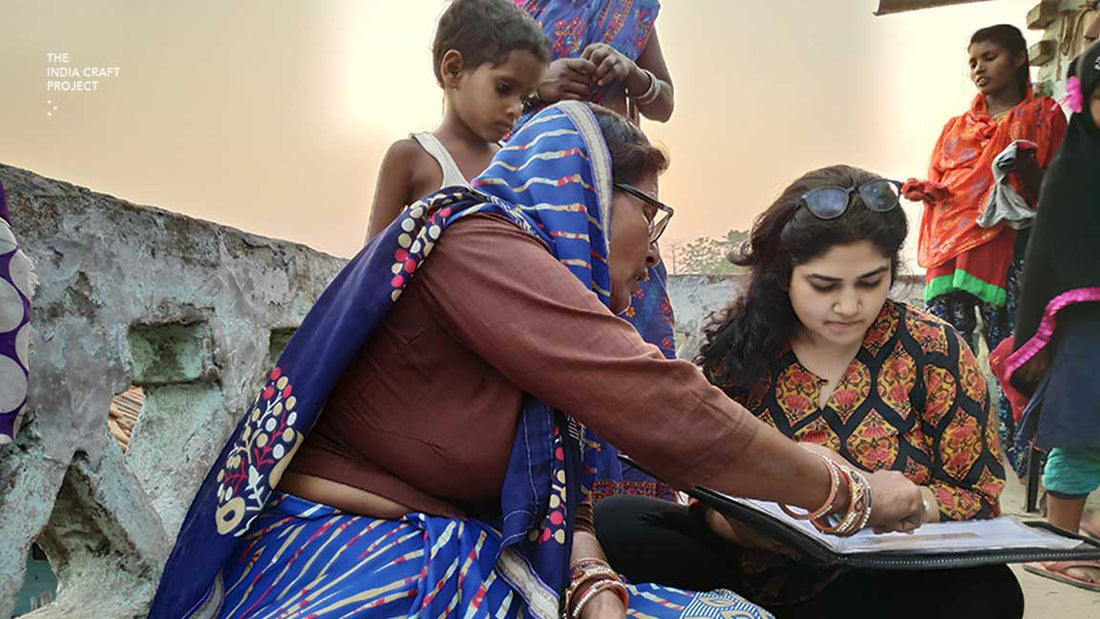Driving through the unlevelled dusty route, our auto stopped at a point with no road to go ahead and coincidentally, THAT was the village we were looking for! Opening the tin doors of a house, we climbed up to the room upstairs and standing on a verandah overlooking the whole settlement of houses was Nazda ji, our lady of the hour. As we scanned our surroundings, we noticed the green fields next to the settlements and soaked in the scenic sunset and the riot of colourful raw materials on the floor. Once we exchanged smiles and introduced ourselves to Nazda Khatunji, a National Awardee in Sikki Grass Craft. We knew it wasn’t just us waiting to talk about the craft. Nazda ji’s eyes sparkled as she taught us, a couple of curious youngsters about her Sikki craft practices.

Sikki is the name given to the variety of grass that is, particularly, grown in the marshy areas of Mithila, Bihar and it is the single most crucial element of the craft. The other variety of grass, called the ‘Moonj’, is used to make the initial supporting structure of the product and then softer grass, the ‘Sikki’ is wrapped, coiled and interlaced around it to create patterns and designs. Nazda ji chose to pick up the craft from her grandmother, who used to create certain household products with it. The craft has not only enhanced her livelihood to a great extent but also added value to her personally.
As she told us of her stories, massive aluminium trunks were toppled and searched for prototypes and folders of visual references, which Nazda ji was keen to show us. The verandah now looked more like an artist’s exhibit, with her sitting in the middle surrounded by her products – flipping through folders, picking out instances via newspaper clipping or old pictures.

Till date, Nazda ji works tirelessly towards training other women, like herself, who wish to contribute to their household incomes. During her early days of propagating the craft, Nazda ji went door to door to encourage women by providing a little ‘Sikki’, initially, to try their hands on. And to this day, she continues to train women in this craft, so they can make use of their time and energy; and contribute towards household income and in turn gain a sense of independence and selfconfidence.
To be used as raw material in Sikki, the grass should be lightgolden in colour. This is usually achieved by drying the grass under the sun and ensuring that the right moisture is left within the grass blade for it to become malleable. Easily available in the local shops around the artisan communities, the grass is, then, dyed using lac dyes to get the desired shade and washed twice before being sun dried one final time.
Only a small tool is needed for handcrafting these beauties, known as a ‘Takua’, a metal tool with a rounded gripping end and the other end with a pointed tip, which is used to split and insert the grass wherever needed.
Initially every woman is taught to perfect the skill by creating various kinds of boxes which are widely used in storing household items. From baskets, it progresses to creating decorative items and then, finally, to utility products with some complex shapes. Today, there is no end to the versatility of the craft and the kind of products that could be created from it. Some examples of products are colourful lampshades, mobile cases, paperweights, pen stands among many other products subject to experimentation.
Passing these skills down to her daughter, Nazda ji believes that now that women are more keen on stepping out of their houses to make a livelihood for themselves, however, the lack of certain crucial skills, prevents them from doing so. They do not possess the proper design expertise and knowledge of other materials which could help them make better products according to market demands. Hence, the women are often limited to making the traditional patterns on new products. Along with that, they are largely dependent on government sources for business opportunities and marketing strategies. The women would like to encourage the younger generation or creativelyminded people who could come over to their village and help them experiment with their Sikki craft to create some innovative products.

Over the years, Khatun has laid great emphasis on the ‘finishing’ of the product to be top-notch which helps in attracting the interest of buyers during exhibitions and displays. She believes that a finished product would be able to move faster rather than a haphazardly finished one. Nazda Ji willingly tries to make limited edition designs in order to attract the attention of customers in these exhibitions.
There comes a time in people’s lives when they wish to leave what they are pursuing, in order to experience something new or chase after new adventures, but in the case of Nazda Khatun ji there is no question changing paths! She intends to keep training till the time she is able to walk and use her hands freely, to train more youth so that the new generation could take the craft forward. She tries to make the craft more viable at every step by keeping up with the in-demand products in the market.
The valour, the spirit and the desire to evolve at every step amongst such artisans is what forms the ethos of The India Craft Project. We salute and look up to such kindred souls who are trying to the best of their abilities, to preserve and pass down indigenous forms of art to the next generation.
